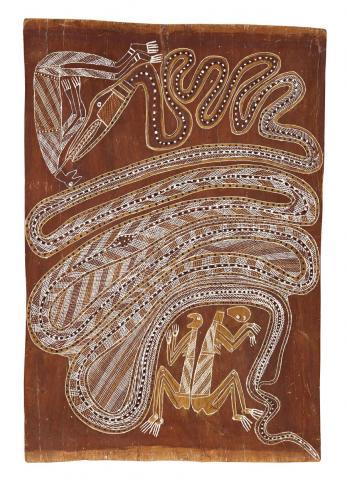KUNAPIPI (SACRED AND SECRET), 1960s
YIRAWALA
natural earth pigments on eucalyptus bark
82.0 x 55.5 cm
inscribed verso: artist's name and cat. Y/4 and 8
Executed at Minjilang, Croker Island, Western Arnhem Land
Collection of Jerome Gould, Los Angeles
Private collection, Sydney
For other examples of the artist's bark paintings of the period held in the collection of the Museum of Contemporary Art, Sydney, see Michael, L., (ed.), They are Meditating, Bark Painting from the MCA's Arnott's Collection, Museum of Contemporary Art, Sydney, 2008, pp. 156–158 and pp. 194–215, and Altman, J., and Perkins, H., Crossing Country: The Alchemy of Western Arnhem Land Art, Art Gallery of New South Wales, Sydney, 2004, pp. 35–37 and pp. 54–56
Yirawala was a pioneer in contemporary Kuninjku art. His innovative and powerful work integrated rock art techniques with the rarrk (crosshatching) design relating to the Mardayin ceremony. The Mardayin rarrk design refers to people's spiritual identity, their ancestral lands and the ancestors who made these lands, essentially identifying people's connection to country.
Yirawala's Mardayin bark paintings are linked to ceremonial body designs, in a scale and form that inherently contain layered meanings. As a senior ceremonial leader, Yirawala had the rights to translate ceremonial knowledge and to integrate rarrk with rock art techniques.
Yirawala was one of a group of artists who were living on Minjilang (Croker Island) in Western Arnhem Land from the 1940s. Others in this group were Jimmy Midjawmidjaw (or Midjau Midau), Samuel Wagbara, Paddy Compass Namatbara and January Nangunyari Namiridali. Minjilang was an unsettled community; the influence of the mission was strong and the island was a place where, until the 1960s, Aboriginal people of socalled'mixed blood' were resettled.
In an atmosphere of uncertainty, these artists produced images of sorcery despite the attempts of the mission to ban such paintings. The artists were encouraged and commissioned to produce these works, as well as a range of other subjects from ceremonial images (such as Kunapipi Sacred Ceremony) to mimih figures, by a number of eminent anthropologists and collectors, including Ronald and Catherine Berndt, Karel Kupka and Tony Tuckson (with Stuart Scougall).
Traditionally, Aboriginal people recognise the making of magic paintings as a benevolent activity in which a loved one may be lured or an animal is painted in anticipation of success in the hunt. Sorcery images, on the other hand, were created with the express purpose of bringing harm to an individual, usually as retribution for sexual infidelity. Yirawala painted a range of these subjects, his animated figures quite distinctive from the figurative drawings of his contemporaries, although the influence of each artist on the others, working in close proximity as they were, is evident.
The salient features of Yirawala's figures are the distinctive profiles of the heads, the gesture and animation of the body and the complex rarrk (cross hatching) infill to his figures and creatures. By the 1950s Yirawala was already an acknowledged senior ceremonial leader and bark painter. His earliest bark paintings were directly connected to the rock art of the Western Arnhem Land escarpment. However, as he grew in ceremonial status, Yirawala began to paint detailed renditions of sacred body designs from ceremonies such as the Mardayin, Lorrkon and Wubarr. Kunapipi is secret and sacred and forbidden to all uninitiated men and boys. It is performed on the men. This depiction of Kunapipi was collected by Californian businessman and graphic designer Jerome Gould in the 1960s. Gould amassed a large collection of bark paintings between the 1960s and 1980s, and over 260 paintings from Gould's collection were purchased by the Arnott's biscuit family and donated to the Museum of Contemporary Art, Sydney in 1993.
